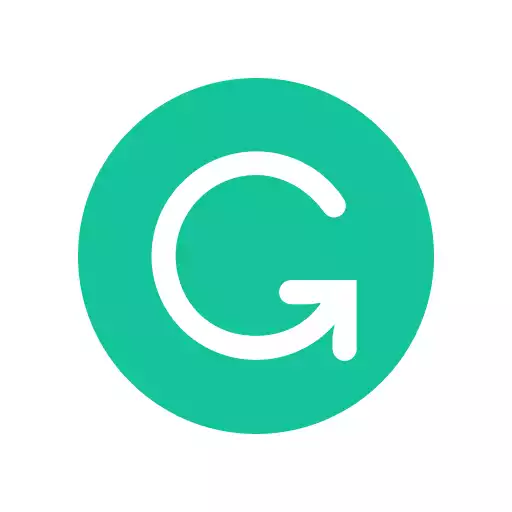Discover the best proofreading software for checking and fixing your writing or the work of other writers in our software guide.
In the late 2000s, I worked as a sub-editor for a national newspaper. We often printed out news stories and proofread them line by line, marking them with proofreading notes using a red pen. Even when proofreading on screen, sub-editors working for the newspaper didn’t rely on special software beyond inline comments and a standard spelling and grammar checker.
The experience was slow and frustrating. Proofreading is much easier today, thanks to the many free and premium tools available. I’ve tested some of the best. These proofreading apps can help independent proofreaders, those working within a company, and writers who simply want to learn the basics of this discipline.
Contents
- 1. Grammarly
- 2. ProWritingAid
- 3. Antidote
- 4. Quillbot
- 5. Ginger Software
- 6. WhiteSmoke
- 7. ProofHQ
- 8. Ziflow
- 9. Hemingway Editor
- 10. Copyscape
- 11. PaperRater
- 12. SlickWrite
- 13. Language Tool
- 14. AutoCrit
- 15. Jasper
- 16. Wordtune
- 17. CorrectEnglish (CE)
- Proofreading Software vs. Human Proofreader
- What Is The Best Proofreading Software?
- Why You Can Trust Me
- Selection Criteria
- FAQs On The Best Proofreading Software
|
5.0
|
4.5
|
|
$30 per month
|
$79 per year
|
1. Grammarly
Use for: General proofreading
Pricing: Free/$30 per month

Grammarly excels as proofreading software. It’s ideal for most writers, editors, and anyone working with the written word. Grammarly’s strength works well across platforms and devices, including Windows and Mac, as well as browsers like Chrome, Firefox, and Safari. Its artificial intelligence writing assistant enables reviewing, accepting, and rejecting mistakes at a click in real-time. I regularly use the Gmail, Chrome extension, and Google Docs plugin to proofread blog posts and the desktop plugin for Mac to proofread articles. You can use it to proofread anything from articles to emails.
If you’re a professional proofreader, chances are the writer or client already uses or has access to the free version of Grammarly. Using Grammarly Premium, you can create a custom style guide and download reports for them to check. At some point, we’d love to see Grammarly roll out version control for proofreaders.
To learn more, read our Grammarly review.
2. ProWritingAid
Use for: Proofreading fiction, long-form proofreading
Pricing: $70 per year
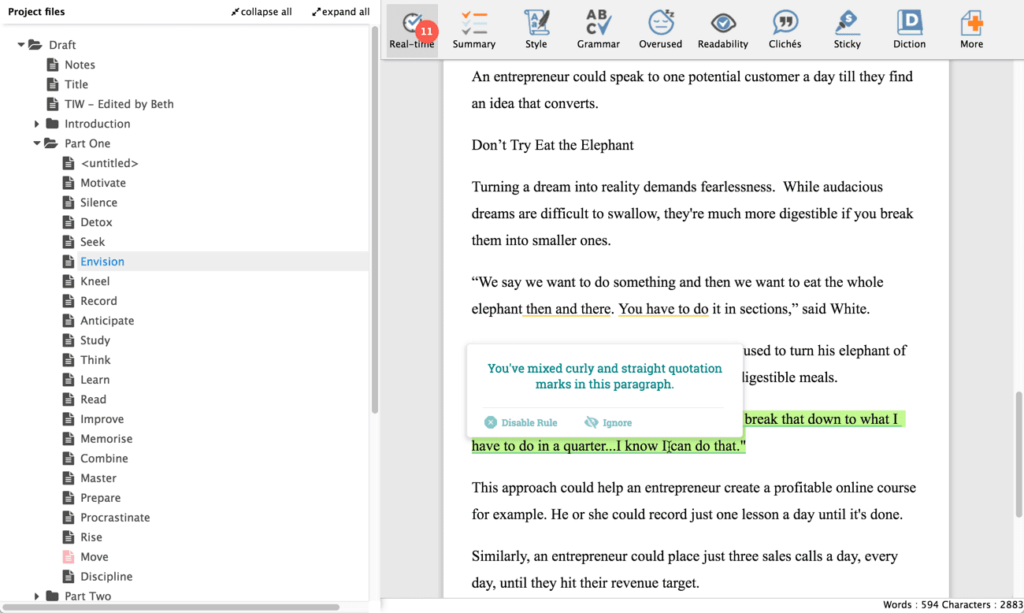
ProWritingAid is an excellent alternative to Grammarly. It works on almost as many devices as Grammarly. It offers dozens of high-quality writing and proofreading reports. Some of these are designed to catch common grammar mistakes and other issues. Others relate to questions of writing style and the overall sentence structure of an article, blog post or essay. We particularly like its reports for addressing word choice and repetitiveness issues.
As a proofreader, you can review and act on these reports or send them to a writer as part of your checks. Many professional writers and authors use Scrivener for long-form works. ProWritingAid is unique because it is purpose-built to work directly with Scrivener files.
This professional editing software is cheaper than Grammarly too. As for downsides? The sheer number of reports can become overwhelming for new users. Mobile support is somewhat lagging, although no serious proofreading works on mobile.
To learn more, read our ProWritingAid review.
3. Antidote
Use for: Proofreading, without internet access
Pricing: From $59.95 per year
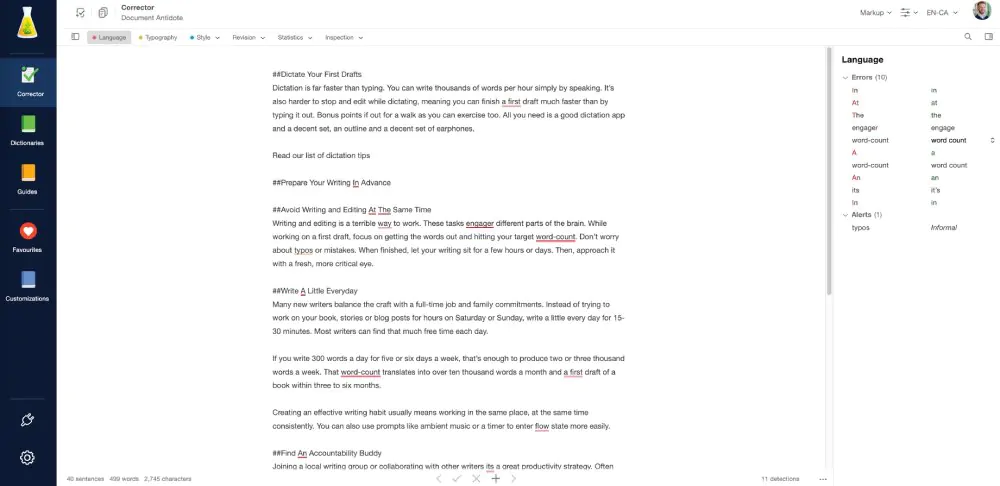
Antidote is a lesser-known type of proofreading software. However, don’t let that deter you. Antidote is rock-solid and has been around for over 25 years, making it the oldest proofreading tool on this list. Proofreaders can pick from three versions: Antidote web, Antidote mobile, and Antidote 11. The web version operates via a browser like Chrome or Safari, while the mobile version works on iOS devices. However, it lacks the same number of browser extensions as Grammarly.
Antidote 11 is installed straight on your computer. It scans and identifies grammar mistakes and other issues using local software rather than sending a piece of writing to the cloud. As such, it’s a good choice for those concerned about privacy and data security and proofreaders with poor internet access. Unlike many proofreading tools, Antidote supports French. It also offers custom dictionaries and a version for schools.
4. Quillbot
Use for: proofreading academic works and essays
Pricing: $19.95 per month
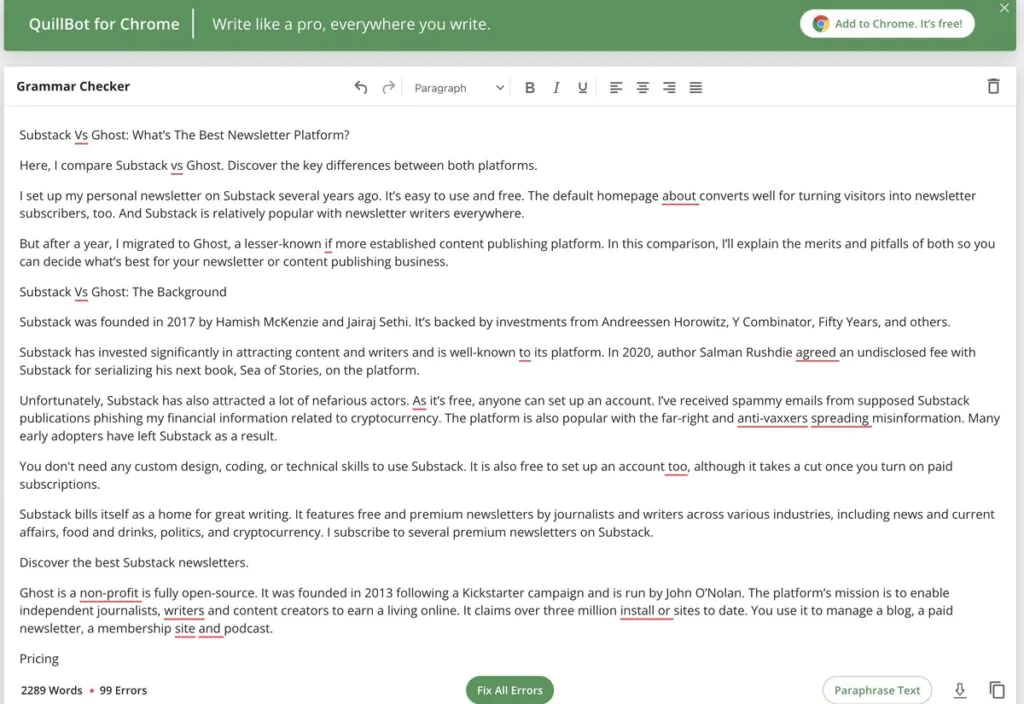
Quillbot is a proofreading tool, amongst other things, released in 2017, with over 50 million users. However, the way it presents errors and reports doesn’t compete with Grammarly and ProWritingAid. Quillbot still functions as a grammar checker, and in our tests, it found and fixed more spelling mistakes, grammar errors, and other issues than our word processor’s built-in software.
We particularly liked the citation generator as it’s time-consuming to proofread these for a these or an essay. This generator automatically formats any link, document, or reference based on a user’s preferred style and generates the correct citation. It’s a good choice for proofreading or editing academic works and essays. Quillbot customers also access other premium tools for rewriting content and checking for plagiarism.
To learn more, read our Quillbot review.
5. Ginger Software
Use for: A cheap proofreading software
Pricing: $7.49 per month

At one point, Ginger Software was a fair competitor to Grammarly in terms of functionality, accuracy, price, and ease of use. Unfortunately, the development of Ginger has lagged behind Grammarly and ProWritingAid. Proofreaders often need more insights than a basic grammar and spell check.
Our tests found it slower and clunkier than these proofreading tools. It also lacks many of the additional proofreading reports and checks they possess and has no customer dictionary. However, it’s still cheap, and it supports 60 languages.
To learn more, read our Ginger vs. Grammarly comparison.
6. WhiteSmoke
Use for: A cheap proofreading software
Pricing: $59.99 per year

In 2002, Itay Meroz founded Whitesmoke in Tel Aviv, Israel. It’s an older type of proofreading software that at one point competed with Grammarly and ProWritingAid in terms of features and accuracy. When we first reviewed WhiteSmoke in 2018, it was slower to use than those tools.
However, it caught more typos and other mistakes in our work without issue. Today, its user interface and reports lag farther behind more popular competitors. It also supports 55 languages.
To learn more, read our Whitesmoke vs. Grammarly comparison.
7. ProofHQ
Use for: Proofreading and collaboration within a larger company
Pricing: ProofHQ isn’t cheap. Expect to pay several hundred dollars per month

If you’re a business and or work with multiple teams, ProofHQ is a good choice for proofreading. ProofHQ doesn’t spot and fix mistakes itself; that’s up to the proofreader. A proofreader uploads documents, for example, PDFs, Microsoft Word documents, etc., into ProofHQ and adds proofreading marks. They can also import URLs and mark up live web pages with proofreading notes.
I used this software extensively while working as an editor for a SaaS company. I reviewed web pages, marked them with changes for the writer, and sent them back as proof that they could review them. It was ideal for collaborating with other writers in different countries. Unfortunately, Adobe acquired ProofHQ, and it’s now sold via Workfront (a project management tool for larger companies). That puts it beyond reach for most proofreaders.
8. Ziflow
Use for: Collaboration and proofs in a small business
Pricing: $20 per user per month

ProofHQ and Workfront aren’t cheap and are also not suitable for many businesses. Enter Zilflow, it offers similar features and functionality to ProofHQ but at a lower price point. Like ProofHQ, you can import documents, URLs, and videos and mark them up with amends for the original creator. In addition, it supports version control and enables users to compare changes between documents.
It’s a good choice if you work with team members or more than basic Word or Google Docs. It’ll help proofreaders collaborate with those who must agree to or approve a document, web page, video, or other assets before publication. That said, it’s up to the proofreader, not the software, to spot mistakes.
9. Hemingway Editor
Use for: general copy edits
Pricing: free/$19.99

Writers cite Hemingway Editor as an excellent tool for copy editing a piece of writing. A writer or proofreader can copy and paste their work into the app or upload a Microsoft Word document, text, HTML, or Markdown file. We love Hemingway Writer for improving sentence structure and writing style. It helps us find and fix instances of weak writing and overused adverbs and adjectives. In addition, it’s great for avoiding wordy writing and improving the general readability of a piece.
However, Hemingway Editor isn’t classic proofreading software. It won’t spot or fix spelling and grammar or classic punctuation errors. It also doesn’t generate reports that a proofreader can use or share. And you can’t use it with Google Chrome or other browsers via a plugin. That said, it’s free. You can buy a version that works locally, without internet access.
To learn more, read our Hemingway App review.
10. Copyscape
Use for: plagiarism checks as part of a proofreading process
Pricing: 3 cents per search, up to 200 words
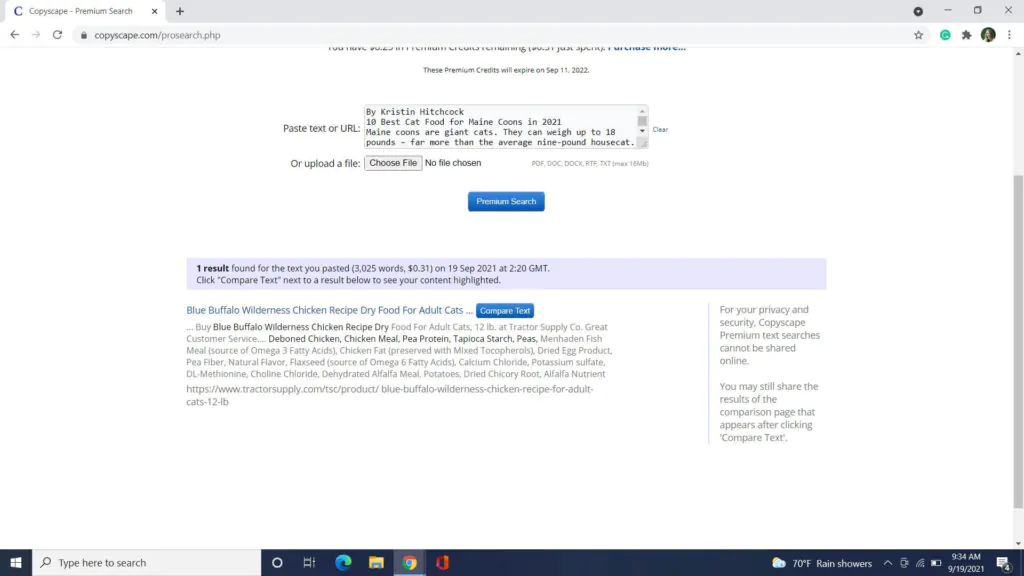
Copyscape isn’t classic proofreading software. It won’t fix common grammar mistakes, spelling errors, and other issues. However, it belongs on this list as it will scan an article for instances of plagiarism, accidental or otherwise. This scan is an essential step for any proofreader checking another writer’s work.
It can help the proofreader protect that writer’s reputation (or the reputation of their company) and also avoid accidental plagiarism. Although ProWritingAid, Grammarly, and Quillbot also include plagiarism reports, Copyscape is better for scanning content at scale, i.e., an entire website or blog.
To learn more, read our Copyscape review.
11. PaperRater
Use for: checking essays and college submissions
Pricing: $7.95 per month
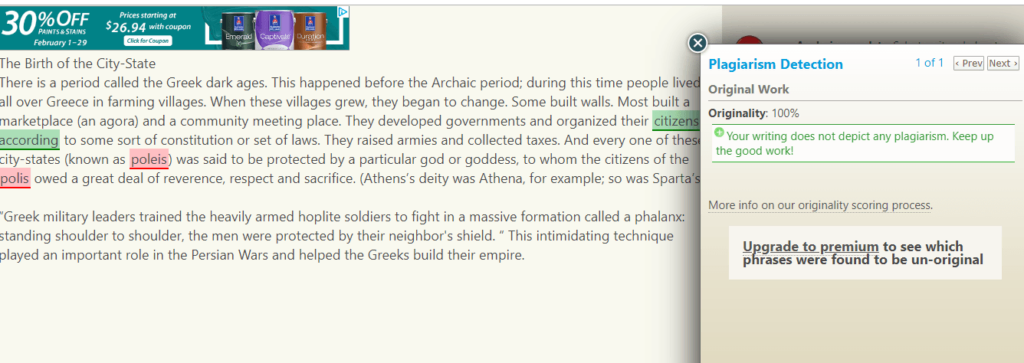
PaperRater is a software that helps students write better essays and articles. It was founded in 2009 and is owned by Barnes and Noble Education. PaperRater uses artificial intelligence to check for spelling mistakes and plagiarism issues.
PaperRater missed some mistakes and other issues that Grammarly caught in our tests during testing. So, don’t expect proofreading reports or collaboration features. However, the pricing is relatively affordable.
To learn more, read our Paperrater vs. Grammarly comparison.
12. SlickWrite
Use for: Proofreading if you’ve no budget
Pricing: Free

SlickWrite is a free online proofreading tool that’s entirely free. No premium version exists. Instead, this software utilizes monetized ads. Paste your text into a web browser. SlickWrite then scans it for writing issues and generates a report with lots of statistics, including readability insights.
Unfortunately, we found the user interface cluttered and distracting versus competitors. If you’re looking for free software, it’s probably easier to use either the basic version of Grammarly or the Hemingway App.
13. Language Tool
Use for: Proofreading in multiple languages
Pricing: From $5 per month
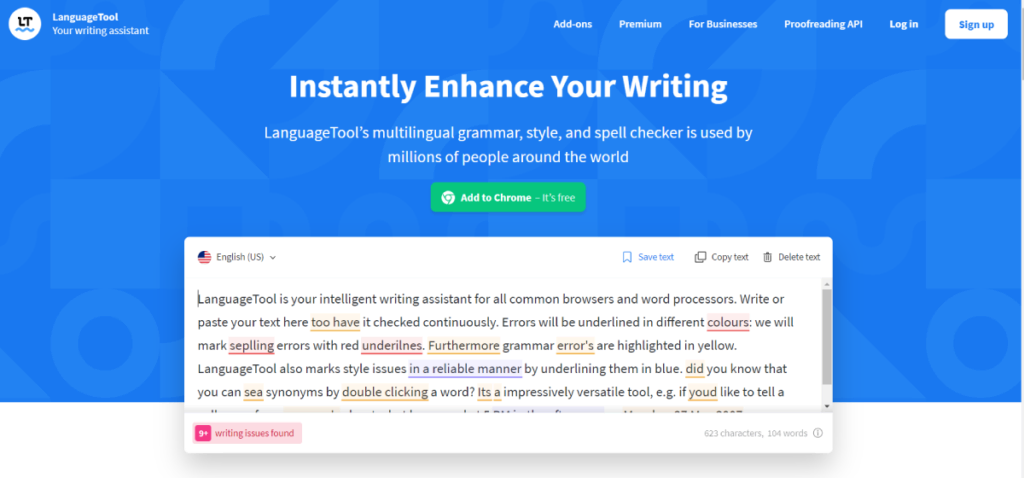
Language Tool is an interesting choice for those who want to proofread content in multiple languages. Unfortunately, few tools support 25 languages, including Arabic, Chinese, Danish, French, and more.
However, proofreaders shouldn’t expect the same level of writing reports as competitors. Users can try the free version and check up to 10,000 characters. The premium version includes add-ins for Microsoft Word and Google Docs.
14. AutoCrit
Use for: editing fiction and novels
Pricing: from $30

AutoCrit differs from other proofreading tools in that it’s built explicitly for authors and fiction writers. Customers take out a membership and gain access to a community. The communities contain premium content, guides, and information for fiction writers.
They also get access to the AutoCrit editing platform. It provides recommendations for improving a manuscript paced on word choice, repetition, pacing, dialogue, and even emotional tone.
These insights are more suited for development editors rather than classic proofreaders. However, if you write fiction, it’s an interesting tool. To learn more, read our Autocrit review
15. Jasper
Use for: Rewriting content, Journalism
Pricing: From $40 per month

Jasper is a copywriting assistant powered by artificial intelligence. It was created by Dave Rogenmoser in 2015 and was previously known as Jarvis. Jasper will not find and fix grammar errors and other mistakes. And proofreaders shouldn’t expect it to generate reports.
However, proofreaders can use it to take clunky copy provided by clients and rewrite or rephrase it quickly and easily. It also helps with time-consuming types of writing that editors and proofreaders are often lumbered with, like meta descriptions and headline variations.
To learn more, read our Jasper AI review.
16. Wordtune
Use for: Rephrasing copy
Pricing: From $9.99 per month
Wordtune is an AI-powered writing tool that works much like Jasper. Again, a proofreader won’t use this tool to fix basic grammar and punctuation mistakes or other readability issues.
However, they can use it to generate, rephrase and edit short blocks of copy quickly and easily. It’s cheaper than Jasper, although it contains fewer AI writing templates. To learn more, read our Wordtune review.
17. CorrectEnglish (CE)
Use for: Checking essays, applying style guides
Pricing: $24 per month
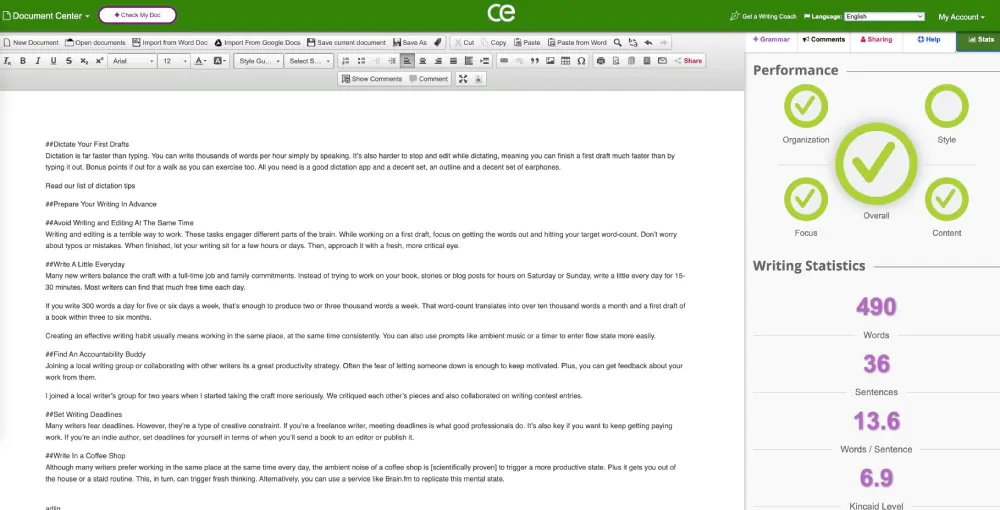
Correct English is lesser-known proofreading focusing on the English academic market and those learning English as a second language. It’s an excellent choice for essayists and proofreaders who work on academic texts. We were able to upload work from Google Docs and Microsoft Word and also copy and paste.
Correct English supports various writing style guides, including APA and MLA. Unfortunately, we’ve yet to find another proofreading tool with a similar feature.
Proofreaders can try the free version and check up to 250 words. The premium version also includes a plagiarism check and access to Lexipedia. Proofreaders can use the latter to look up definitions, synonyms, and antonyms.
Proofreading Software vs. Human Proofreader
Proofreading software is a tool writers and professional proofreaders can use to find and fix errors faster. These tools help get something ready to publish faster.
For longer pieces of work, they are not a replacement for a human proofreader. Professional authors employ multiple proofreaders to check their works for mistakes rather than simply relying on software.
For example, a human proofreader decides when to break a grammar or spelling rule because of a question of style or tone. A serious writer should budget for this type of service.
What Is The Best Proofreading Software?
After testing proofreading software extensively, we found that most independent proofreaders will get the most value from Grammarly. This is because it works everywhere and has a best-in-class writing assistant.
Those editing long-form works should consider ProWritingAid due to the volume of reports. Antidote is a good alternative for proofreaders who dislike these tools. Professional proofreaders in small businesses can also improve their ability to collaborate by using dedicated software like Ziflow.
Why You Can Trust Me
I worked as a professional sub-editor for several national newspapers and completed several proofreading courses.
On Become a Writer Today, I’ve worked with writing software reviewers to profile many of the best tools and apps, including the proofreading tools features here.
Selection Criteria
We regularly update this roundup as proofreading tools. We test new features by checking articles, book chapters, and blog posts for grammatical mistakes and other issues. These articles and other writing samples range from several hundred to several thousand words. Typically, we test them using the web, desktop, and browser apps and plugins.
Our selection criteria include assessing pricing, ease of use, app integration, functionality, and accuracy. We carefully consider each of these aspects when rating software.
FAQs On The Best Proofreading Software
What software do professional proofreaders use?
Up until recently, many professional proofreaders worked in Microsoft Word. Therefore, they rely on their attention to detail and knowledge of English grammar. They also regularly refer to the dictionary, thesaurus, and writing style books. However, professional proofreaders rely on premium software like Grammarly and other tools.
While proofreading, they usually change the formatting of an article to Courier and one and a half or two times spacing and scan it for errors and mistakes manually. Sometimes, they print out a piece of writing, check for issues and mark it up with a red pen.
Is Grammarly better than a proofreader?
Grammarly is a helpful tool for any writer and proofreader. However, best not to accept every suggestion and recommendation without question. A good proofreader understands when to apply and breaks grammar rules, and edits a piece of writing based on style and not only AI. For longer-form works and near 100% error-free writing, it’s worth hiring a professional human proofreader or commissioning proofreading services.

